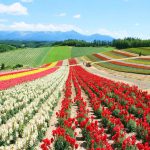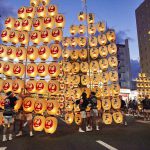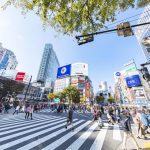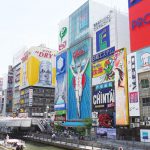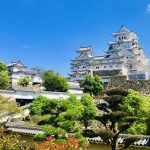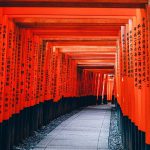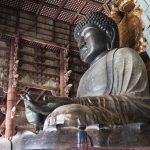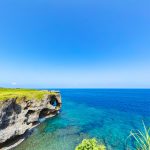Western Honshu (Chugoku)
The western part of Honshu consists of five prefectures, Tottori, Shimane, Okayama, Hiroshima, and Yamaguchi, and is also called the Chugoku region. The Chugoku Mountains, that run from east to west, occupy the central area of the region. To the north, Tottori and Shimane, also known as the Sanin Region, are on the Sea of Japan side. To the south, Okayama, Hiroshima, and Yamaguchi, also known as the Sanyo Region, are on the Seto Inland Sea side. The Sanin region sees a lot of snow in the winter, and some areas of the region experience heavy snowfall, while the climate in the Sanyo region produces very little rainfall throughout the year.
Tottori
The Tottori Sand Dunes stretch 16 km from east to west, and 2.4 km from north to south, and you can enjoy camel riding, sand boarding, and paragliding. The Sand Museum, located near the dunes, is the world’s first museum to display spectacular world-class sand sculptures.
Mt. Daisen (1,729 meters), also called Mt. Hoki Fuji, is the highest peak in the Chugoku region. It has been regarded as a mountain where the gods have dwelled since ancient times. Daisenji Temple flourished as a training center for Shugendo (mountain asceticism) monks. Along the longest stone-paved path in Japan, which continues 700 meters from Daisenji Temple, you will find the Ogamiyama Shrine with its magnificent pavilion. Mt. Daisen is a popular place for hiking, camping, and skiing.
Nageiredo Hall, the inner shrine of Sanbutsu-ji Temple, was built on the sharp cliff of Mt. Mitoku (900 meters high). It has been worshipped since the end of the 11th century (late Heian period), and is so unique that visitors wonder how it was built; it is a designated national treasure.
Sakaiminato is a port town known for its locally-caught crab, and is also the birthplace of Mizuki Shigeru, creator of the popular manga series “GeGeGe no Kitaro.” The characters from the manga can be seen displayed all over the town in the form of yokai (supernatural monsters) bronze statues, Kitaro trains, and giant murals.
Tottori is famous for its Nijuseiki Pear in agricultural products; and Inshu Washi for traditional handicrafts, which maintains a 50% share of Japan’s calligraphy paper market.
Shimane
The Adachi Museum of Art, located in Yasugi, Shimane Prefecture, applies the basic principle of harmonizing Japanese gardens with Japanese paintings. The collection of approximately 120 works of Yokoyama Taikan, a master of modern Japanese painting, is the most extensive in the world in both quantity and quality. Collectively, the Japanese garden consists of six gardens, including a white sand and green pine garden, dry landscape garden, and moss garden; they are spectacular in all four seasons. It has been selected as the best garden in Japan annually since 2003 by Sukiya Living (The Journal of Japanese Gardening), an English-language magazine specializing in Japanese gardens that is based in the United States.
Many myths set in Izumo in Shimane Prefecture are written in the Kojiki and Nihonshoki, Japan’s representative history books. Izumo Taisha Shrine is a symbol of the mythical country of Izumo, known as the god of marriage and good fortune. The gods of the shrine unite not only men and women, but also provide enrichment for all living things. The Izumo Taisha Shrine, along with the Ise Jingu Shrine in Mie Prefecture, is considered to be the most highly revered of all shrines in Japan.
In the worship hall called the Kaguraden, a large, sacred, 3-meter-thick rope will surely capture your attention. Further along is the Main Shrine, which is a designated national treasure. Built in 1744, the Main Shrine currently stands at about 24 meters. However, in ancient times, it was believed to be about 96 meters; four times as high as it is today. During the Heian period, it was about 48 meters high.
It is said that gods from all over the country gather in Izumo in October of the lunar calendar, and will stay in the Jukusha, two wooden structures located on the east and west sides of the Main Shrine. Izumo Taisha Shrine holds kami-mukae (welcoming of the gods) and enmusubi (“tying the knot”; marriage) festivals at this time of the year. The festivals are also held at Hinomisaki Shrine, Asayama Shrine, and other shrines in the area, so it is a good time to visit Izumo.
Tsuwano is a castle town with a history that dates back more than 700 years. It is known as the “Little Kyoto of the Sanin region,” and the old white-walled streets still remain. Taikodani Inari Shrine is one of Japan’s five great Inari shrines. The torii gate tunnel, consisting of approximately 1,000 vermillion-lacquered toriis leading to the shrine, is an extraordinary sight to see.
In addition, Lake Shinji is known as one of Japan’s leading waterfowl destinations with a beautiful sunset view, and is registered under the Ramsar Convention. The Iwami Silver Mine, a designated World Heritage Site, produced one-third of the world’s silver at one time. The hot springs town of Yunotsu still retains the atmosphere of the days when it flourished as a shipping port for the Iwami Silver Mine. The area is also famous for the traditional craft of making Sekishu Washi paper.
Okayama
In 1597, when Okayama Castle was built, Okayama came into prosperity as a castle town. Korakuen Garden, one of Japan’s three most beautiful gardens, was created in 1700. It was commissioned by a powerful daimyo (feudal lord) of the Edo period, and serves as a fine representation of that era. The spacious garden includes a pond and tea houses, and provides a stunning view of Okayama Castle.
Kibitsu Shrine is dedicated to the god of Kibitsuhiko no Mikoto, believed to have inspired the famous Japanese fairy tale “Momotaro” (Peach Boy). The main hall and worship hall exhibit the traditional Shinto architectural style of kibitsu-zukuri; rebuilt in 1425, they are designated as national treasures. Also recommended are the shrine’s 400-meter-long corridor, built in the Warring States period; and the “Narugama ritual,” a type of fortune-telling that utilizes the sound of a boiling pot of water.
The tower of Bicchu Matsuyama Castle is one of twelve surviving original castle towers built prior to the Edo period, and is the only mountaintop castle among them. Built on a mountaintop 430 meters above sea level, it is called the “Castle in the Sky,” because it appears to be floating in a sea of clouds, especially from October to November.
Kurashiki became a fief of the Edo shogunate in the 17th century, and prospered as a transport base for various goods. You can visit the Kurashiki Bikan Historical Quarter, where white-walled residences and old storehouses remain along the Kurashiki River; and Kojima, a town that is highly popular for its numerous denim jeans stores.
Hiroshima
The city of Hiroshima was the site of the world’s first atomic bombing in 1945, and is known around the world as an international city of peace and culture. The Peace Memorial Park was built near the hypocenter, and is dedicated to promoting world peace. The park includes the Hiroshima Peace Memorial Museum, that exhibits artifacts describing the devastation of the atomic bombing; the Atomic Bomb Dome that remains in the same state as immediately after the bombing; the Memorial Cenotaph to the Atomic Bomb Victims, where the annual Hiroshima Peace Memorial Ceremony is held; the Peace Bell; and various other memorial towers and statues.
Located less than an hour from Hiroshima Station by train and ferry, Miyajima has long been regarded as a divine island. Itsukushima Shrine, with its beautiful vermillion torii gate and shrine buildings that appear to float on the sea, was built at the end of the 6th century. The present shrine was built in the 12th century by Taira no Kiyomori, a warlord of the Heian period.
Mt. Misen in Miyajima is 535 meters high, and it is said that Kobo Daishi (also known as Kukai) practiced ascetic Buddhism there. It has been an object of mountain worship since ancient times. There is a mountain climbing trail, as well as an aerial tram that can transport visitors to the summit of the mountain, where the view is spectacular. Many visitors come to the shrine on day trips from Hiroshima, however, an overnight stay is recommended to fully experience the sacred atmosphere of Miyajima. The illuminated buildings at night, and the early morning stillness of the deserted shrine entryway are mysteriously magical.
Other recommended destinations include the Shimanami Sea Route, where you can enjoy scenic cycling tours; Senkoji Temple, famous for its cherry blossoms and view of the Seto Inland Sea; Tomonoura, where the streets have been preserved since the Edo period; Sandankyou, known for its clear streams and beautiful gorges; and Kumano, known for manufacturing Kumano brushes, highly coveted by Hollywood actresses and makeup artists.
Yamaguchi
Hagi prospered as a castle town for the Choshu domain from the 17th to 19th centuries, and produced many prominent figures from the end of the Tokugawa shogunate to the Meiji Restoration. Many politicians from the Meiji era and beyond also rose into prominence. Because it escaped war damage and did not undergo major development, the town’s original landscape and layout remain as they were; such examples are Horiuchi Kaimagari and Kikuya Yokocho Street. In addition, the maps from the Edo period remain functional. Tokoji Temple is the family temple of the Mori clan that ruled the Choshu domain. The main gate, Daio-hoden (main hall), and bell tower are wonderfully preserved; and the 500 stone lanterns are also quite spectacular.
The Kintaikyo Bridge is a wooden bridge that measures 193 meters in length, and 5 meters in width. It was built in 1673 by a traditional construction method, and features five beautiful and unique arches. It is said to have been renovated over 100 times, and is considered to be one of the three most famous bridges in Japan. It is surrounded by cherry blossoms in the spring, and colorful foliage in autumn.
Other attractions in Yamaguchi include the castle town of Chofu, known for Chofu Garden; Kozanji Temple; and Rurikoji Temple with its five-story pagoda built in 1442. Akiyoshidai, the largest limestone plateau in Japan, and the 10-km long Akiyoshido Limestone Cave are also famous. Shimonoseki, well-known for its many historical sites and fugu (blowfish) cuisine, is another recommended destination; it is bordered by the Kanmon Straits and connected to Kyushu by the Kanmon Bridge.


